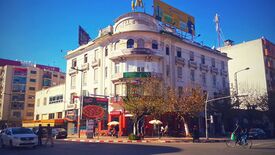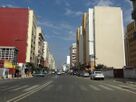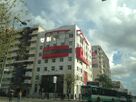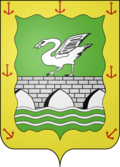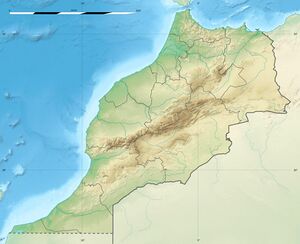Kenitra
Topic: Place
 From HandWiki - Reading time: 5 min
From HandWiki - Reading time: 5 min
Kenitra
| |
|---|---|
Avenue Mohamed Diouri, Avenue Mohamed V, Kenitra | |
| Coordinates: [ ⚑ ] 34°15′N 6°35′W / 34.25°N 6.583°W | |
| Country | |
| Region | Rabat-Salé-Kénitra |
| Province | Kenitra |
| Founded | 1st Century BC (as Thamusida), 1912 (Modern city) |
| Area | |
| • Total | 112 km2 (43 sq mi) |
| Elevation | 26 m (85 ft) |
| Population (2014)[1] | |
| • Total | 431,282 |
| • Rank | 9th in Morocco |
| Time zone | UTC+1 (CET) |
| Website | http://www.kenitra.ma/ar/ |
Kenitra (Arabic: القُنَيْطَرَة, al-qunayṭara, [alqunajtˤira], lit. the little bridge;[2] Social:Berber languages: ⵇⵏⵉⵟⵔⴰ, romanized: Qniṭra; French: Kénitra) is a city in northwestern Morocco, known as Port Lyautey from 1932 to 1956. It is a port on the Sebou River with a population of 431,282 as of 2014.[3] It is one of the three main cities of the Rabat-Salé-Kénitra region and the capital of the similarly named Kénitra Province. During the Cold War, the US Naval Air Station Port Lyautey served as a stopping point in North Africa.
History
Ancient history
The history of the city begins with the foundation of a trading post by the Carthaginian, known back then as Thamusida. Under the Antonine dynasty, a Venus temple was built there.[citation needed]
Colonial and recent history
In March 1912 the French government and the Sultan of Morocco, Abd al-Hafid, signed the Treaty of Fez. Because of his growing unpopularity, the Sultan asked the French government for protection against the Berber rebel tribes surrounding Fez. France appointed Hubert Lyautey resident-general in Morocco.
General Lyautey restored peace and order to the country after crushing the tribal uprising. After safely moving the Sultan from Fez to the current capital city, Rabat, Lyautey began his task of civilian administration.
One of the first preoccupations of General Lyautey was to build ports along the inhabitable Atlantic coast where there were no natural harbors. He established Port Lyautey in 1912 as a French military fort and town. Its port, at the mouth of the Sebou river, was opened in 1913.[4] It soon became the best river port in Morocco.[5] Kenitra draws its name from a culvert built at Fouarat lake upstream of the kasbah. This culvert was destroyed in 1928. In 1933, the French officially named the locale "Port Lyautey".
It was renamed "Quneitra" in 1956 as Morocco gained its independence. The city has grown rapidly to be a shipping centre for agricultural produce (mainly fruit), fish, timber, and lead and zinc ores. The city's industrial area lies upstream of the port.
In November 1942, after Operation Torch, the Americans captured the Port Lyautey French fighter base as a military base, named Craw Field. For three months the 21st Engineer Aviation Regiment worked on the airfield. In February 1943 the Seabees of the 120th Naval Construction Battalion took over all construction activities.[6] The Navy ran the base until 1947, when the State Department negotiated reversion of control to France. In 1950, a $23,000,000 expansion was authorized, but then the Korean War diverted resources. In the 1950s, nearly 10,000 people were on the base making it the largest aggregation of Americans in any one overseas base outside Japan. Later, the base in Kenitra was expanded to become a U.S. Naval Air Station.[7]
The base was shared by both the US and Morocco through the Cold War. A small Navy communications out-station in Sidi Yahia closed in the late 1970s. The Air Station was closed in 1991.
Climate
Kenitra has a hot-summer Mediterranean climate (Köppen climate classification Csa). Script error: No such module "weather box".
Population
| 1982 | 1994 | 2004 | 2010 | 2014 |
|---|---|---|---|---|
| 187,000 | 291,000 | 358,000 | 400,000 | 430,000 |
Areas and neighbourhoods
- Mdina
- Khabazate
- The Cigogne
- La cite
- Modern city
- Mimosa
- La Ville Haute
- Popular districts
- Saknia
- Ouled Oujih
- Maghrib al Arabi
- Residential districts
- Bir Rami
- Ismailia
- Val fleuri
Education
Colleges and universities
- Université Ibn-Tofail (ar) (UIT)[11]
- ENCG Kénitra (École nationale de commerce et de gestion de Kénitra (fr))
- HECI Kénitra (Hautes Etudes Commerciales et Informatiques)
- ENSA Kénitra (École nationale des sciences appliquées de Kénitra)
- ENSC Kénitra ([École nationale supérieure de chimie de Kénitra]
Transportation
- The National Route 1 and the A1 motorway pass through Kenitra and connect it to Rabat-Salé in the south-west and to Larache in the north-east.
- The city is served by one railway station: Kenitra-Ville. A shuttle train, TNR, connects the city, every 30 minutes, to Rabat and Casablanca.
- A high-speed rail line to Tangier was completed in 2018.[12] (See Kenitra–Tangier high-speed rail line.)
Sports
Kenitra Athletic Club, KAC
In 1938, a group of Kenitra natives created KAC.
This group of soccer lovers wanted to resist French domination in sports in Morocco.
The team, made entirely of Kenitra natives, succeeded in reaching the premier Moroccan soccer league in 1956. In 1960, KAC won its first championship league of Morocco. KAC embarked in a journey of glories by winning the 1973-81-82 championship leagues and the 1961 throne cup.
Ahmed Souiri was a long-time manager and coach. KAC has produced many international players.
Noureddine Bouyahyaoui and Labid Khalifa were among the players who helped the Moroccan national soccer team qualify for the second round of the World Cup finals in Mexico in 1986. Mohammed Boussati still holds a national record of goals by scoring 25 goals in one soccer championship season in 1981–82.
Its home is the Kenitra Municipal Stadium which has a capacity of 15,000 people.[13]
Basketball
The KAC Kénitra was a very successful basketball team during the 70s and 80s.
Natives from Kenitra
Kenitra was the birthplace of:
- Saïd Aouita, Olympic athlete
- Amina Aït Hammou, Olympic athlete
- Youssef Chippo, International football player
- Margie Cox, American R&B Singer
- Mohamed Sijelmassi, writer and physician
- David Bitan, Israeli politician
- Nayef Aguerd – Moroccan footballer
- Sofian Chakla – Moroccan footballer
- Zouhair Laaroubi - Moroccan footballer
- Tariq Chihab - Former international footballer
- Karl Stephan - American artist and educator
See also
- Bouknadel
- Battle for Port Lyautey
Notes and references
- ↑ "POPULATION LÉGALE DES RÉGIONS, PROVINCES, PRÉFECTURES, MUNICIPALITÉS, ARRONDISSEMENTS ET COMMUNES DU ROYAUME D'APRÈS LES RÉSULTATS DU RGPH 2014" (in ar, fr). High Commission for Planning, Morocco. 8 April 2015. http://rgph2014.hcp.ma/file/166326/.
- ↑ Team, Almaany. "ترجمة و معنى قنيطرة بالإنجليزي في قاموس المعاني. قاموس عربي انجليزي مصطلحات صفحة 1" (in en). https://www.almaany.com/ar/dict/ar-en/%D9%82%D9%86%D9%8A%D8%B7%D8%B1%D8%A9/.
- ↑ "Population légale d'après les résultats du RGPH 2014 sur le Bulletin officiel N° 6354" (in ar). hcp.ma. http://www.hcp.ma/file/167575/.
- ↑ Kénitra depuis 1912 (in French)
- ↑ In Morocco by Edith Wharton, New York: Charles Scribner's Sons 1920
- ↑ Port Lyautey, Chapter XX, The Mediterranean Area, Building the Navy's Bases in World War II, History of the Bureau of Yards and Docks and the Civil Engineer Corp, 1940-1946, Volume II, UNITED STATES GOVERNMENT PRINTING OFFICE, WASHINGTON, p. 80[1]
- ↑ "History of Port Lyautey". http://www.portlyautey.com/Port%20Lyautey%20History.htm.
- ↑ "World Meteorological Organization Climate Normals for 1981–2010". World Meteorological Organization. https://www.ncei.noaa.gov/pub/data/normals/WMO/1981-2010/RA-I/Morocco/WMO_Normals_ASCII_60120.csv.
- ↑ "Kenitra Climate Normals 1961–1990". National Oceanic and Atmospheric Administration. https://www.ncei.noaa.gov/pub/data/normals/WMO/1961-1990/TABLES/REG__I/FM/60120.TXT.
- ↑ "Kenitra, Morocco Metro Area Population 1950-2020 – macrotrends.com". https://www.macrotrends.net/cities/21894/kenitra/population.
- ↑ "Univesité Ibn Tofail – Univesité Ibn Tofail". 6 February 2006. http://www.uit.ac.ma//.
- ↑ "'Africa's fastest train' steams ahead in Morocco". https://www.aljazeera.com/news/2018/11/africa-fastest-train-steams-morocco-181115165325722.html.
- ↑ "Stade Municipal de Kénitra – StadiumDB.com". http://stadiumdb.com/stadiums/mar/stade_municipal_de_kenitra.
External links
- Entry in Lexicorient
- Pictures of U.S. Naval base facilities in Kenitra
- Histoire de Kenitra / Port-Lyautey en images de 1911 au 1956
[ ⚑ ] 34°15′N 6°35′W / 34.25°N 6.583°W
 |
 KSF
KSF